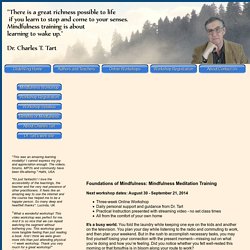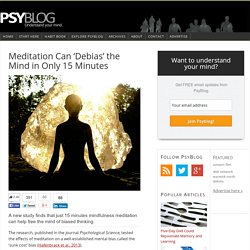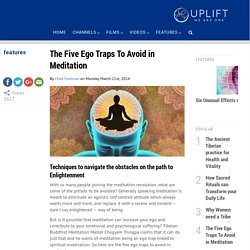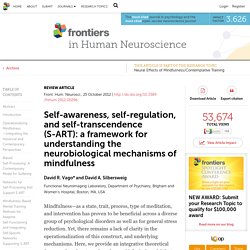

Shamatha et Vipashyana : présentation générale — Study Buddhism. Quand vous avez expliqué les types de méditation, il y en avait trois, dont la concentration.

Et tous les trois, plus ou moins, impliquent une sorte d’activité mentale. Ma question est la suivante : est-il possible d’atteindre un certain niveau d’accès à des méditations élevées – comme shamatha à vipashyana et au tantra et dzogchen – sans avoir développé la concentration au moyen de shamatha ? Non, pas que je sache. Je veux dire par là que les instructions et ouvrages variés afférents à la méditation, dont j’ai eu connaissance à travers des lectures ou des enseignements oraux, posent l’exigence du développement de la concentration en premier. Maintenant, savoir s’il est nécessaire ou non de développer le plein niveau de shamatha tel qu’il est défini est une autre question. Ainsi, que ce soit dans la méditation dzogchen ou dans une méditation habituelle du tantra ou autre méditation de niveau avancé, ces éléments seront présents.
Les Tibétains croient dur comme fer aux vies futures. Buddhānusmṛti. Pratītyasamutpāda. Pratītyasamutpāda (Sanskrit: प्रतीत्यसमुत्पाद; Pali: पटिच्चसमुप्पाद paṭiccasamuppāda) is commonly translated as dependent origination or dependent arising.

The term is used in the Buddhist teachings in two senses: On a general level, it refers to one of the central concepts in the Buddhist tradition—that all things arise in dependence upon multiple causes and conditions.On a specific level, the term is also used to refer to a specific application of this general principle—namely the twelve links of dependent origination. Etymology[edit] Mettā. One of the ten pāramīs of the Theravāda school of Buddhism Mettā (Pali) or maitrī (Sanskrit) means benevolence,[1] loving-kindness,[2][3] friendliness,[3][4] amity,[4] good will,[5] and active interest in others.[4] It is the first of the four sublime states (Brahmaviharas) and one of the ten pāramīs of the Theravāda school of Buddhism.

The cultivation of benevolence (mettā bhāvanā) is a popular form of Buddhist meditation.[6] It is a part of the four immeasurables in Brahmavihara (divine abidings) meditation.[7] Metta as 'compassion meditation' is often practiced in Asia by broadcast chanting, wherein monks chant for the laity.[6] Patikulamanasikara. Type of traditional Buddhist meditation Translation[edit] Paṭikkūla (Pāli) literally means "against" (paṭi) "the slope" or "embankment" (kūla) and has been translated adjectivally as "averse, objectionable, contrary, disagreeable" and, in its nounal form, as "loathsomeness, impurity".[3]

Anapanasati. Ānāpānasati is now common to Tibetan, Zen, Tiantai and Theravada Buddhism as well as Western-based mindfulness programs.

Zen. Zen is a school of Mahayana Buddhism[note 1] that developed in China during the Tang dynasty as Chán.

From China, Zen spread south to Vietnam, northeast to Korea and east to Japan. Zen emphasizes rigorous meditation-practice, insight into Buddha-nature, and the personal expression of this insight in daily life, especially for the benefit of others. As such, it deemphasizes mere knowledge of sutras and doctrine and favors direct understanding through zazen and interaction with an accomplished teacher. The teachings of Zen include various sources of Mahāyāna thought, especially Yogācāra, the Tathāgatagarbha Sutras and Huayan, with their emphasis on Buddha-nature, totality, and the Bodhisattva-ideal.
Méditation Vipassana: Vipassana : une méditation pour la vie de tous les jours. A Beginner’s Guide To Meditation · Expo Yoga. Mind Body and Meditation. Harvard Unveils MRI Study Proving Meditation Literally Rebuilds The Brain’s Gray Matter In 8 Weeks. Test subjects taking part in an 8-week program of mindfulness meditation showed results that astonished even the most experienced neuroscientists at Harvard University. The study was led by a Harvard-affiliated team of researchers based at Massachusetts General Hospital, and the team’s MRI scans documented for the very first time in medical history how meditation produced massive changes inside the brain’s gray matter.
Mindfulness Online Workshop. It’s a busy world.

You fold the laundry while keeping one eye on the kids and another on the television. You plan your day while listening to the radio and commuting to work, and then plan your weekend. But in the rush to accomplish necessary tasks, you may find yourself losing your connection with the present moment—missing out on what you’re doing and how you’re feeling. Did you notice whether you felt well-rested this morning or that forsythia is in bloom along your route to work? Mindfulness is the practice of purposely focusing your attention on the present moment—and accepting it without judgment. The cultivation of mindfulness has roots in Buddhism, but most religions include some type of prayer or meditation technique that helps shift your thoughts away from your usual preoccupations toward an appreciation of the moment and a larger perspective on life. Mindfulness improves well being Mindfulness improves physical health Mindfulness improves mental health.
Featured - What Meditation Really Is. Meditation Can ‘Debias’ the Mind in Only 15 Minutes. A new study finds that just 15 minutes mindfulness meditation can help free the mind of biased thinking.

The research, published in the journal Psychological Science, tested the effects of meditation on a well-established mental bias called the ‘sunk cost’ bias (Hafenbrack et al., 2013). The sunk cost bias refers to the fact that people find it difficult to give up on a goal into which they’ve already made a large investment. Even once the goal has gone stale or proven unworkable, there’s a tendency to throw good money (or effort) after bad, simply because a significant investment has already been made. “Well,” people say to themselves. “We’ve come this far…” The Five Ego Traps To Avoid in Meditation. With so many people joining the meditation revolution, what are some of the pitfalls to be avoided?

Generally speaking meditation is meant to eliminate an egoistic self centred attitude which always wants more and more, and replace it with a serene and content – dare I say enlightened – way of being. But is it possible that meditation can increase your ego and contribute to your emotional and psychological suffering? Tibetan Buddhist Meditation Master Chogyam Trungpa claims that it can do just that and he warns of meditation being an ego trap linked to spiritual materialism. So here are the five ego traps to avoid in meditation. 1. This is probably the most obvious trap, or at least it is obvious to others if you go around claiming you are enlightened, but it is also the most subtle and hard to understand.
Self-awareness, self-regulation, and self-transcendence (S-ART): a framework for understanding the neurobiological mechanisms of mindfulness. Functional Neuroimaging Laboratory, Department of Psychiatry, Brigham and Women's Hospital, Boston, MA, USA Mindfulness—as a state, trait, process, type of meditation, and intervention has proven to be beneficial across a diverse group of psychological disorders as well as for general stress reduction.

Stress and Your DNA. Getting your finger pricked at work for a blood sample is not something you’d expect elite advertising execs to agree to. But, on a warm July day in 2015, fifteen members of a premier advertising agency in San Francisco interrupted their busy schedules and lined up in their office to do just that: They each provided a finger-prick blood sample. These were some of the most hard-working minds in the company—partners, directors, managers and team specialists—from operations to HR to creative. Passionate about their craft and desire to impact in the world, they also struggled with some semblance of “work-life balance.” They were eager to learn how to transform their high levels of stress into wellbeing. As I watched the blood samples dry and packaged them to ship to the Social Genomics Core Lab at UCLA, I was overcome with a nervous excitement.
Meditation in Action: How Daily Activities Can Naturally Induce Meditative States. By Phillip J. Watt Guest Writer for Wake Up World. Neuroptimal® Powered by Zengar, Home Neurofeedback Therapy, ADHD. Benefits of Meditation 101: How To Meditate In Less Time. Harvard Scientists Found Something Surprising About People Who Meditate. Nine Stages of Training the Mind.